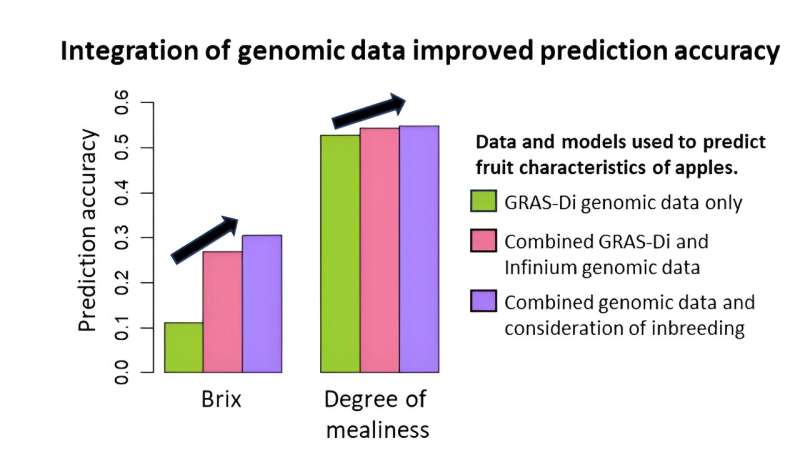This article has been reviewed according to Science X's editorial process and policies. Editors have highlighted the following attributes while ensuring the content's credibility:
fact-checked
peer-reviewed publication
trusted source
proofread
Genomic data integration improves prediction accuracy of apple fruit traits

Over the past few decades, the world has witnessed tremendous progress in the tools used for genomic analysis. While it's usually more common to associate these tools with the fields of biology and medicine, they have proven to be very valuable in agriculture as well.
Using numerous DNA markers obtained from next-generation sequencing technologies, breeders can make genomic predictions and select promising individuals based on based on their predicted trait values.
Various systems and methodologies aimed at improving the quality of fruits use genetic analysis. One of them consists of genetic selection (GS) and genetic prediction (GP).
This modern breeding approach uses statistical models to assess the entire genetic profile of a given individual based on previously collected genomes and their associated traits. This enables breeders to make predictions about the fruit traits that will be produced in the future at the seedling stage.
In contrast, genome-wide association studies (GWAS) are instead focused on finding the exact genetic variants that are responsible for a particular fruit trait.
Until now, GP and GWAS have predominantly used DNA markers from a single system, and when the system in use became obsolete, it had to be re-analyzed using a more up-to-date system. However, it has been difficult to re-analyze populations for selection in fruit tree breeding that have been analyzed in previous systems, as it is not possible to re-obtain DNA from individuals discarded during selection.
In a study published in Horticulture Research on 8 July 2024, a research team led by Associate Professor Mai F. Minamikawa from the Institute for Advanced Academic Research, Chiba University, Japan, set out to clarify whether combining apple data from different systems could lead to more accurate results when performing GP and GWAS.
Other members of the team included Dr. Miyuki Kunihisa from the Institute of Fruit Tree and Tea Science, National Agriculture and Food Research Organization, Japan, and Professor Hiroyoshi Iwata is from the Graduate School of Agricultural and Life Sciences at the University of Tokyo, Japan.
First, the researchers combined apple datasets acquired from two different genotyping systems, namely Infinium and genotyping by random amplicon sequencing direct (GRAS-Di). Then, they used these combined genotype markers to perform GP and GWAS for a total of 24 different fruit traits, including acidity, sweetness, harvest time, and solid soluble content.
The team compared the performance of predictions made using models trained on either dataset alone or both combined.
The results were very encouraging; the accuracy of genomic predictions and the detection power of the GWAS system increased significantly when using the Infinium and GRAS-Di combined datasets for multiple fruit traits. This suggests there are benefits to combining data from different systems and leveraging historical data.
To push the envelope further, the researchers also trained the GP model in such a way that inbreeding effects were considered. Interestingly, these results also hinted at the combined approach performing better for certain traits, including Brix and Degree of mealiness.
Still, these findings were less conclusive, as Dr. Minamikawa says, "Although the accuracy of GS for fruit traits in apples can be improved by data on inbreeding, further studies are needed to understand the relationship between fruit traits and inbreeding."
Overall, the findings of this study hint at a convenient way of improving the accuracy of GS and GWAS by leveraging existing datasets.
This could have many positive implications in agriculture, as Dr. Minamikawa says, "The challenges such as large plant size and long juvenile periods in fruit trees can be addressed by identifying superior genotypes from numerous individuals using high accuracy GS as seedling stage and detecting genetic variants for a target trait using precise GWAS."
More information: Mai F Minamikawa et al, Genomic prediction and genome-wide association study using combined genotypic data from different genotyping systems: application to apple fruit quality traits, Horticulture Research (2024). DOI: 10.1093/hr/uhae131
Journal information: Horticulture Research
Provided by Chiba University





















